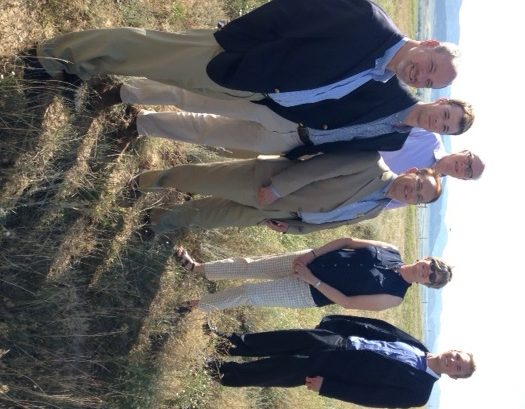For well over a decade, Vanderbilt Engineering alumnus Brock Smethills (BE’13) and his family have been driving to a picturesque spot just south of Denver, envisioning the futuristic wonderland it would become.
Houses where the residents pay mere pocket change for utilities thanks to solar power and a one-of-a-kind system that lets them shed electrical devices when rates are most expensive. Tidy streets lined with poles that convey critical information using colorful LED uplighting. A school system envisioned by leading minds in education, partnering with a tech industry that draws thousands of scientists and engineers to the region.
But the people they picture living in that new community, called Sterling Ranch, aren’t all techies or freecyclers. The goal is to make homes and neighborhoods so comfortably livable, residents barely notice they’re helping save the planet.

Smethills, Sterling Ranch’s chief operating officer, explained that vision and how Vanderbilt University School of Engineering will be a major part of it to the school’s Senior Design Seminar on Wednesday. Sterling Ranch also is taking center stage for the school’s fall Board of Visitors meeting on Friday.
“Imagine designing a community with technology and sustainability of this scale from the ground up,” said School of Engineering Dean Philippe Fauchet. “The research opportunities for our graduate and undergraduate students are virtually limitless and span the disciplines.”
The development covers 3,400 acres and will include 12,050 residential units housing 45,000 people when it is built out 20 years from now. Five Senior Design teams – groups of fourth-year engineering undergraduates – will complete projects for use in Sterling Ranch this year. Professors and Ph.D. candidates will create sustainable water and energy systems and the technology to manage those over the next two decades.
They’ll work in conjunction with a number of corporate partners, including Siemens and IBM, which is designing a fiber optic system to deliver 1Gbit of internet speed to every home, Smethills told the group.
“Unlike Nashville, Denver was not fortunate enough to become a Google city, but we’ve done our best to enable that type of technology,” he said.
Sterling Ranch also is providing learning opportunities for education majors in Peabody College of education and human development, because they will be helping design new schools and learning methods that incorporate the next-gen community around them. That cooperation among project leaders on Vanderbilt’s side earned them one of seventeen new Trans-Institutional Program grants, funding offered by the university to encourage collaborative research and teaching efforts.

Smethills told students on Wednesday that Sterling Ranch will include multiple elementary and middle schools and a high school at build-out.
He explained a marketing strategy that would appeal to both Baby Boomers and Millennials, the largest buying groups. His engineering background helped inform that process, he said.
“It’s very complex, using that quantitative engineering aspect to forecast the future, come up with base assumptions and model those,” Smethills said. “We’re using technology to market to younger demographics, but letting older buyers know they don’t have to use it if they don’t want it. You can completely automate your house or just use the technology for a security system keypad.”
In addressing water issues in Colorado’s drought-prone Front Range, Smethills and others on the project wondered: What if the runoff from Sterling Ranch’s rooftops and streets could be captured and reused to nourish vegetation in community parks and other common areas?
It took a five-year effort in the state legislature to convince lawmakers to grant permission for 10 such pilot projects to try that across the state. So far, Sterling Ranch is the only one. Gov. John Hickenlooper signed an extension of the original 2009 law at Sterling Ranch’s June groundbreaking.
Already, two Vanderbilt engineering interns have enjoyed a taste of Sterling Ranch’s educational benefits — Carlton Jester (CmpE’17) and Alexander Macklis (CE’16). Macklis said his role as chapter president of the American Society for Civil Engineers opened a seat at the table for initial partnership talks. Later, he emailed Smethills and landed a summer internship.
Macklis’s tours of duty included coordinating with Sterling Ranch’s telecom provider Lumiere, plus working with Dominion Water and Mortensen Construction. For several weeks, he traded his comfortable digs at Sterling Ranch’s corporate offices for a double-wide construction trailer on site.
“Things happened better than I ever could have planned them,” Macklis said. “I thought going into this internship, it would narrow the scope of my professional interests. But because I was exposed to so much cool stuff, it has actually expanded them, which is a great thing.
“I need to take some time to really think about where I want to head professionally, because out there, I found a number of projects I could happily work on for the next 10 years.”
Smethills graduated summa cum laude with a bachelor of engineering in mechanical engineering and formerly worked for Lockheed Martin and United Launch Alliance. During his time at Vanderbilt, Brock was president of the American Society for Mechanical Engineers and the team captain for Vanderbilt’s NASA University Student Launch Initiative team. Under his leadership, the Vanderbilt team beat out 42 other universities, marking the first time Vanderbilt won after competing in the USLI for six years.
Contact
Heidi Hall, 615-322-6614
Heidi.Hall@Vanderbilt.edu
On Twitter @